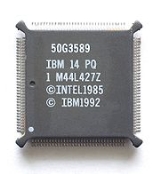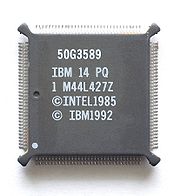
386SLC
Encyclopedia
The 386SLC was an Intel-licensed version of the 386SX (32-bit internal, 16-bit external, 24-bit memory addressing), developed and manufactured by IBM
in 1991. It included power-management capabilities and an 8KB internal cache
, which enabled it to yield comparable performance to 386DX processors of the same clock speed, which were considerably more expensive. Known inside IBM as "Super Little Chip" for its initials, it was used in IBM PS/2 35, 40 56 Series and in IBM PS/ValuePoint
, but never gained much market share. This was mainly due to an agreement with Intel, in which IBM was not allowed to sell their CPUs if they were not part of a system or upgrade board. It was also marketed as an optional upgrade
for 8086
-equipped IBM PS/2 25 Series computers.
(CMOS
) technology, the IBM 386SLC had a 161-square millimeter die
. It was available with clock speeds of 16, 20, and 25 MHz. The 25 MHz model produced only 2.5 watt
s of dissipated power, making it specially well suited for laptops and other portable devices.
Despite the fact that the SLC and DLC chips are bus compatible with i386SX and i386DX respectively, they can not be used as drop-in replacements as they are not pin-compatible.
part, yielding performance broadly comparable to a similarly-clocked 486SX in the 16-bit applications of its day. However, its narrow 16-bit bus, limited memory addressing capability (16 MB) and lack of on-chip FPU would prove to be major disadvantages under the new generation of 32-bit operating systems (such as Windows 95
) that would become popular in following years.
It is suspected the clock tripled 486SLC3 part did not in fact actually exist as a stand alone product. All known instances of 486SLC3 CPUs are reportedly in the 132pin PQFP packaging with the extra address lines not connected (a 486BL3 running in 16-bit mode).
 The 486DLC is a fully 32-bit version of the 486SLC, with 1.4 mln transistors on the 82mm² die and 0.8 µm CMOS. It came in a 132-pin QFP package. In July, 1993 IBM produced clock-doubled and clock-tripled versions of the chip, the 486DLC2 (486BLX2) and the 486DLC3 (486BLX3) respectively. The chips were available from 50 to 100 MHz and were sold by IBM only. IBM later marketed 168-pin PGA Blue Lightning 486 CPUs, but these are technically not related to earlier Blue Lightning models as they are based on the Cyrix
The 486DLC is a fully 32-bit version of the 486SLC, with 1.4 mln transistors on the 82mm² die and 0.8 µm CMOS. It came in a 132-pin QFP package. In July, 1993 IBM produced clock-doubled and clock-tripled versions of the chip, the 486DLC2 (486BLX2) and the 486DLC3 (486BLX3) respectively. The chips were available from 50 to 100 MHz and were sold by IBM only. IBM later marketed 168-pin PGA Blue Lightning 486 CPUs, but these are technically not related to earlier Blue Lightning models as they are based on the Cyrix
CPU core.
IBM
International Business Machines Corporation or IBM is an American multinational technology and consulting corporation headquartered in Armonk, New York, United States. IBM manufactures and sells computer hardware and software, and it offers infrastructure, hosting and consulting services in areas...
in 1991. It included power-management capabilities and an 8KB internal cache
Cache
In computer engineering, a cache is a component that transparently stores data so that future requests for that data can be served faster. The data that is stored within a cache might be values that have been computed earlier or duplicates of original values that are stored elsewhere...
, which enabled it to yield comparable performance to 386DX processors of the same clock speed, which were considerably more expensive. Known inside IBM as "Super Little Chip" for its initials, it was used in IBM PS/2 35, 40 56 Series and in IBM PS/ValuePoint
IBM PS/ValuePoint
The IBM PS/ValuePoint personal computer was IBM's answer to the PC clone market, where the IBM PS/2 could not compete due to price and proprietary interfaces. Announced in October 1992 and withdrawn in July 1995, it was replaced by the IBM PC Series 300.These systems used standard ISA-bus...
, but never gained much market share. This was mainly due to an agreement with Intel, in which IBM was not allowed to sell their CPUs if they were not part of a system or upgrade board. It was also marketed as an optional upgrade
Upgrade
The term upgrade refers to the replacement of a product with a newer version of the same product. It is most often used in computing and consumer electronics, generally meaning a replacement of hardware, software or firmware with a newer or better version, in order to bring the system up to date...
for 8086
Intel 8086
The 8086 is a 16-bit microprocessor chip designed by Intel between early 1976 and mid-1978, when it was released. The 8086 gave rise to the x86 architecture of Intel's future processors...
-equipped IBM PS/2 25 Series computers.
Design and Technology
Built with complementary metal oxide semiconductorSemiconductor
A semiconductor is a material with electrical conductivity due to electron flow intermediate in magnitude between that of a conductor and an insulator. This means a conductivity roughly in the range of 103 to 10−8 siemens per centimeter...
(CMOS
CMOS
Complementary metal–oxide–semiconductor is a technology for constructing integrated circuits. CMOS technology is used in microprocessors, microcontrollers, static RAM, and other digital logic circuits...
) technology, the IBM 386SLC had a 161-square millimeter die
Die (integrated circuit)
A die in the context of integrated circuits is a small block of semiconducting material, on which a given functional circuit is fabricated.Typically, integrated circuits are produced in large batches on a single wafer of electronic-grade silicon or other semiconductor through processes such as...
. It was available with clock speeds of 16, 20, and 25 MHz. The 25 MHz model produced only 2.5 watt
Watt
The watt is a derived unit of power in the International System of Units , named after the Scottish engineer James Watt . The unit, defined as one joule per second, measures the rate of energy conversion.-Definition:...
s of dissipated power, making it specially well suited for laptops and other portable devices.
Despite the fact that the SLC and DLC chips are bus compatible with i386SX and i386DX respectively, they can not be used as drop-in replacements as they are not pin-compatible.
IBM 486SLC
Is an improved version of the IBM 386SLC, based on the Intel core. IBM 486SLC featured 16Kb of L1 cache and the i486 instruction set. It had 1.349 mln. transistors and a 69mm² die. It was manufactured in 1992. It came in a 100-pin PQFP packge, with 33 MHz FSB speed. The 486SLC was also available in a clock-doubled version, the 486SLC2 (50,66 MHz), and later in a clock tripled-version, the 486SLC3 (60,75,100 MHz). Clock-for-clock, it was substantially faster than the similarly-named CyrixCyrix
Cyrix Corporation was a microprocessor developer that was founded in 1988 in Richardson, Texas as a specialist supplier of high-performance math coprocessors for 286 and 386 microprocessors. The company was founded by former Texas Instruments staff members and had a long but troubled relationship...
part, yielding performance broadly comparable to a similarly-clocked 486SX in the 16-bit applications of its day. However, its narrow 16-bit bus, limited memory addressing capability (16 MB) and lack of on-chip FPU would prove to be major disadvantages under the new generation of 32-bit operating systems (such as Windows 95
Windows 95
Windows 95 is a consumer-oriented graphical user interface-based operating system. It was released on August 24, 1995 by Microsoft, and was a significant progression from the company's previous Windows products...
) that would become popular in following years.
It is suspected the clock tripled 486SLC3 part did not in fact actually exist as a stand alone product. All known instances of 486SLC3 CPUs are reportedly in the 132pin PQFP packaging with the extra address lines not connected (a 486BL3 running in 16-bit mode).
IBM 486DLC (Blue Lightning)

Cyrix
Cyrix Corporation was a microprocessor developer that was founded in 1988 in Richardson, Texas as a specialist supplier of high-performance math coprocessors for 286 and 386 microprocessors. The company was founded by former Texas Instruments staff members and had a long but troubled relationship...
CPU core.
See also
- Intel 386
- IBM PS/2
- IBM PS/ValuePointIBM PS/ValuePointThe IBM PS/ValuePoint personal computer was IBM's answer to the PC clone market, where the IBM PS/2 could not compete due to price and proprietary interfaces. Announced in October 1992 and withdrawn in July 1995, it was replaced by the IBM PC Series 300.These systems used standard ISA-bus...
- IBM ThinkPad
- IBM 5x86C - based on the CyrixCyrixCyrix Corporation was a microprocessor developer that was founded in 1988 in Richardson, Texas as a specialist supplier of high-performance math coprocessors for 286 and 386 microprocessors. The company was founded by former Texas Instruments staff members and had a long but troubled relationship...
core - IBM Personal Computer

